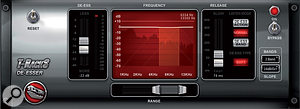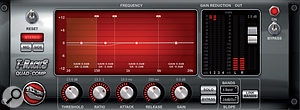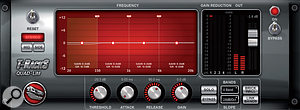IK's flagship suite of plug-in processors continues to grow, with the addition of a channel strip and several handy multi-band modules.
Developed originally for mastering, but also very useful for mixing, IK Multimedia's T-Racks is one of the best-known plug-in suites around. In its latest CS Grand incarnation, it comprises 10 dynamics processors, three equalisers, a 'British' console channel strip, a de-esser and a multi-band stereo width controller. IK have extended their Custom Shop model, first seen in their Amplitube amp simulator, to allow users to demo and buy additional modules from within CS Grand. There is 64-bit native support, and oversampling is used in the plug-ins to avoid aliasing distortion that would otherwise occur with non-linear processing. VST, RTAS and Audio Units formats are supported, and T-Racks can be used stand-alone, but there's currently no AAX version.
 The five new modules in the CS Grand version of T-Racks are, from top, British Channel, De-Esser, Quad Image, Quad Comp and Quad Limiter.
The five new modules in the CS Grand version of T-Racks are, from top, British Channel, De-Esser, Quad Image, Quad Comp and Quad Limiter.
 The new modules are the Quad-series multi-band processors, which comprise Quad Comp, Quad Lim and Quad Image, plus De-Esser and British Channel. The last emulates the dynamics and EQ section of a well-loved British console that I might hazard is solidly built, stately in appearance and logical in operation! British Channel offers four-band parametric equalisation with high- and low-pass filters, a VCA-type compressor and a separate expander/gate. These modules join the existing plug-ins, which include emulations of classic gear such as the Fairchild 670 compressor, Pultec's EQP1A tube programme equaliser, and compressors inspired by the classic Universal Audio 1176 and LA2A hardware.
The new modules are the Quad-series multi-band processors, which comprise Quad Comp, Quad Lim and Quad Image, plus De-Esser and British Channel. The last emulates the dynamics and EQ section of a well-loved British console that I might hazard is solidly built, stately in appearance and logical in operation! British Channel offers four-band parametric equalisation with high- and low-pass filters, a VCA-type compressor and a separate expander/gate. These modules join the existing plug-ins, which include emulations of classic gear such as the Fairchild 670 compressor, Pultec's EQP1A tube programme equaliser, and compressors inspired by the classic Universal Audio 1176 and LA2A hardware.
Out Of Its Shell
Once CS Grand has been authorised by the new and more efficient online system, you have the choice of using its modules either as independent plug-ins or within the CS Grand 'shell', which can operate as a stand-alone program or plug-in. The shell has eight insert slots, plus global metering, and an area where the controls of one module at a time can be viewed and adjusted. The first four slots can accept two modules each; these will then work in two parallel chains before being summed prior to feeding through the final four slots. A comprehensive metering display resides at the bottom of the window and shows phase, loudness and a spectrum analysis, as well as levels. Practical benefits of the shell approach include not only its metering, parallel routing and ability to save processor combinations, but the fact that the master bypass button bypasses all the plug-ins in one go, so you can do a true A/B comparison without having to bypass plug-ins individually.
 The first new module I tried was the console strip. This has a very capable EQ section that is straightforward to operate and sounds musical, as well as being adequately assertive. Its compressor section also works predictably and smoothly, making it a very practical means of polishing individual tracks or bus mixes. The de-esser can be set to two-band operation, where everything above the crossover frequency is dipped on encountering sibilance, or three-band operation, where frequencies both above and below the sibilance region can be left untouched. You can adjust the upper and lower limits of the band being processed in three-band mode using a simple slider, and careful setting of these limits can help minimise the lisping artifacts that heavy de-essing often creates. All the usual listen modes are available, so you can hear what the filter is doing and how the processing is affecting the audio in the selected band. This is by no means the only de-esser to work in this way, but it makes a welcome addition to the package, and its wide control range makes it useful on instruments as well as voices.
The first new module I tried was the console strip. This has a very capable EQ section that is straightforward to operate and sounds musical, as well as being adequately assertive. Its compressor section also works predictably and smoothly, making it a very practical means of polishing individual tracks or bus mixes. The de-esser can be set to two-band operation, where everything above the crossover frequency is dipped on encountering sibilance, or three-band operation, where frequencies both above and below the sibilance region can be left untouched. You can adjust the upper and lower limits of the band being processed in three-band mode using a simple slider, and careful setting of these limits can help minimise the lisping artifacts that heavy de-essing often creates. All the usual listen modes are available, so you can hear what the filter is doing and how the processing is affecting the audio in the selected band. This is by no means the only de-esser to work in this way, but it makes a welcome addition to the package, and its wide control range makes it useful on instruments as well as voices.
Grand Bands
That leaves those multi-band processors. I welcome the addition of a stereo image processor, as I always liked the one built into the Drawmer Masterflow mastering unit. Quad Image lets you adjust the stereo image width in each of four frequency bands: a typical use would be narrowing the stereo width or even converting the signal entirely to mono at low bass frequencies without affecting the mid-range, while the highs are widened beyond their normal range to add an airy spaciousness to the mix. The multi-band compressor has long been used as a problem-solving tool in both mixing and mastering. For example, if your singer's voice gets a little edgy on certain notes, you can apply more compression in the specific relevant band to help tame it. Both Quad Comp and Quad Lim can operate in normal stereo or M/S mode; the latter feature means you can apply corrective processing at the mastering stage or across a whole mix, affecting only the centre-panned elements or only those elements panned to the left and right extremes. Multi-band limiters can be less obtrusive than full-band limiters, as loud bass notes will have less of a tendency to duck the upper end of the spectrum. With this one, you can apply a surprising amount of limiting before giving the game away. Parameter adjustments are global, which makes sense, as having different limit settings for each band could seriously unbalance your audio!
Conclusion
There's a certain amount of fine detail relating to the control options of each plug-in that can't be covered in a review of this length, but doing practical tests on the new modules proved them to be very capable performers, and a welcome addition to what was already a very attractive mixing and mastering package. Classic and Deluxe versions are available at a lower price point and comprise fewer modules, but when you consider that some single plug-ins cost more than the entire Grand bundle, it has to be considered a real bargain.
Alternatives
There are comparable plug-ins from other manufacturers for most of the individual modules within T-Racks CS Grand, especially those that emulate vintage hardware, but it wouldn't be easy to find a single bundle that covers all the same ground. Perhaps the nearest rivals are Izotope's Ozone and Alloy.
Pros
- Solid audio quality.
- Very configurable, thanks to the provision of shell plug-in and stand-alone version.
- Clear interface with comprehensive metering.
- Exceptional value.
Cons
- No AAX support yet.
Summary
T-Racks CS Grand is a great-value collection of genuinely useful mixing and mastering plug-ins with the bonus of the shell program's metering, the ability to integrate other IK T-Racks software on your system, such as their reverbs, and the ability to purchase individual modules to expand the lighter versions of T-Racks.
information
IK Multimedia +44 (0)1223 234414.


